Using a new operating system can be a lot of fun. But it often becomes confusing when we first use it, especially for new users who are not very familiar with computer systems. For those of you who are using Fedora Linux for the first time and have successfully installed Fedora 34 Workstation, this article can be an initial guide. I’m sure that you want to feel more at home with your new fresh Fedora Linux system. These are several things to do after installing your Fedora 34 Workstation.
System update
Maybe you think that you have installed the most recent version of Fedora 34 Workstation, so your Fedora Linux should be up to date. But you still have to make sure that your Fedora Linux has all the updated packages. Because in every new release of an operating system, usually there are still many things that continue to be improved. You can use the terminal or GNOME software to run the update.
If you want to update via the terminal, then you just have to open a terminal and type the following command.
$ sudo dnf update
But if you want to do it with GNOME Software, open the application by selecting Activities then locating and selecting the Software item in the taskbar at the bottom of the screen. When it opens select the Updates tab at the top. After that you just click the Download button. An update may require a restart afterwards and Update will tell you that.
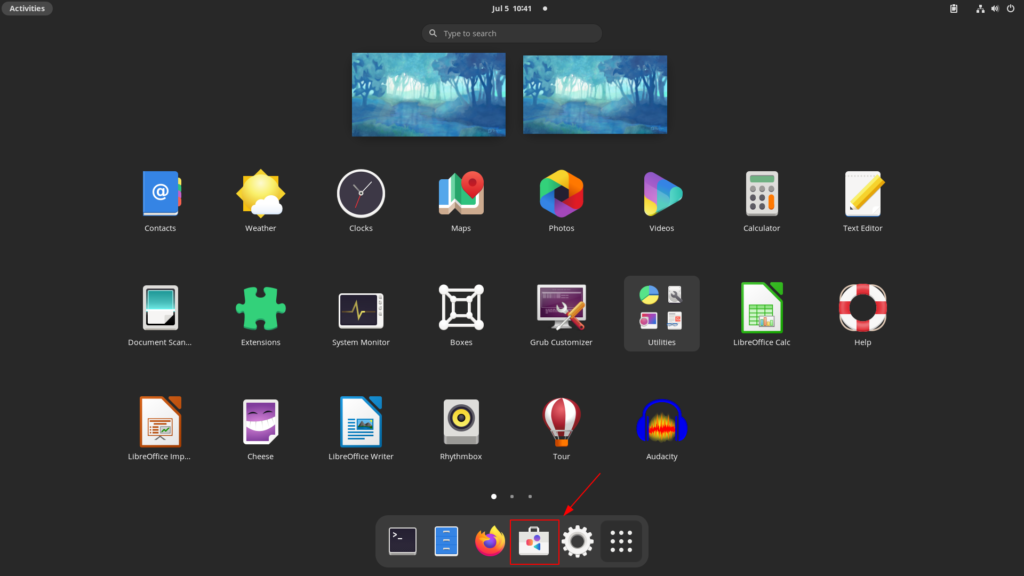
note: another way to select Activities is to press the super key on the keyboard. Super key is the button that has the Windows logo on most keyboards.
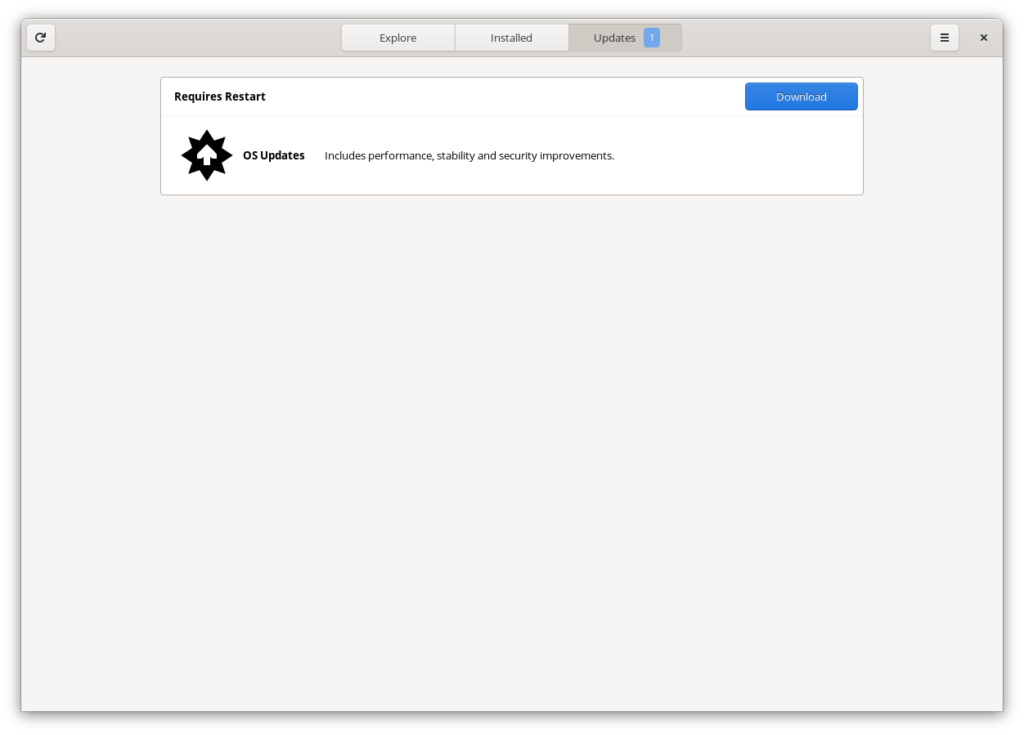
System settings
You can view and configure your device’s system through System Settings. These include items like network, keyboard, mouse, sound, displays, etc. You can run it by pressing the super key on your keyboard, clicking Show Applications in the task bar at the bottom of the window, then selecting Settings. Configure it according to your needs.
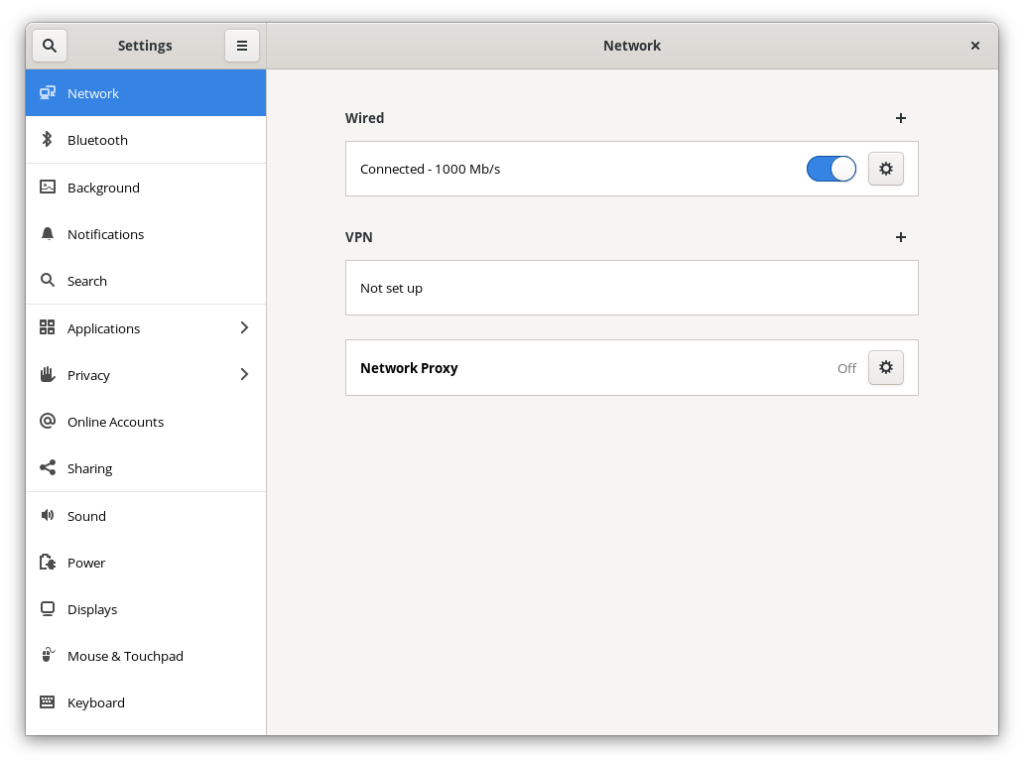
Additional repositories
Maybe some packages you need are not available to be installed from the official Fedora Repository. You can add software repositories with the dnf config-manager command. Please be careful if you want to add other repositories besides the official Fedora repository.
The first thing you should do is define a new repository by adding a new file ending in .repo to the /etc/yum.repos.d/ directory. Run the following command in the terminal.
$ sudo dnf config-manager --add-repo /etc/yum.repos.d/file_name.repo
note: replace file_name with the repository file name.
Or you can use GNOME Software. Open it as described in the System Update section above. Now select the “hamburger” icon (three horizontal lines) on the top right and select Software Repositories. You can add the repository from there using the Install option.
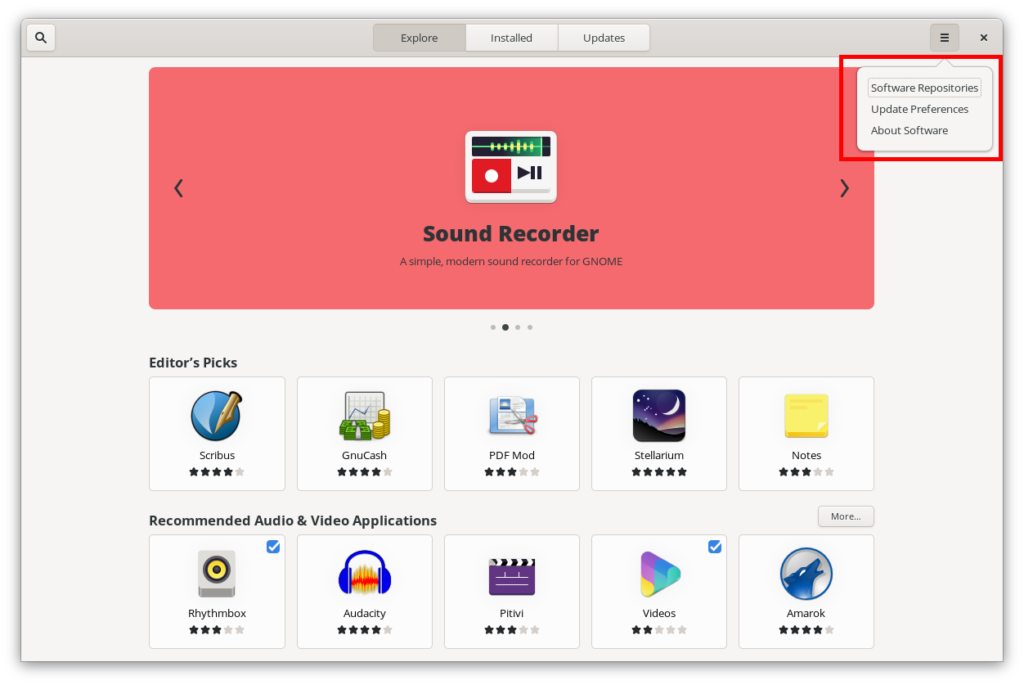
Most people will enable RPM Fusion. It’s a third party repository. You can read about third party repositories in Fedora Docs.
Fastest mirror and Delta RPM
There are several things you can do to speed up your download times when using DNF to update your system. You can enable Fastest Mirror and Delta RPM. Edit /etc/dnf/dnf.conf using a text editor, such as gedit or nano. Here’s the example to open dnf.conf file with nano in terminal.
$ sudo nano /etc/dnf/dnf.conf
Append the following line onto your dnf.conf file.
fastestmirror=true deltarpm=true
Press ctrl+o to save the file then ctrl+x to quit from nano.
Multimedia plugins for audio and video
You may need some plugins for your multimedia needs. You can install multimedia plugins by running this command in a terminal.
$ sudo dnf group upgrade --with-optional Multimedia
Please pay attention to the regulations and standards in your country regarding multimedia codecs. You can read about this in Fedora Docs.
Tweaks and Extentions
Fedora 34 Workstation comes with GNOME as the default Desktop Environment. We can do various configurations of GNOME by using Tweaks and Extensions, like changing themes, changing buttons in the window dialog, and many more.
Open your terminal and run this command to install GNOME Tweaks.
$ sudo dnf install gnome-tweaks
And run this command to install GNOME Extensions.
$ sudo dnf install gnome-extensions-app
Do the same way as above when you search for GNOME Software. Select Activities or press the super key then select Show Applications to see a list of installed applications. You can find both applications in the list. You can do the same thing every time you want to search for installed applications. Then do the configuration with your preferences with Tweaks and Extensions.

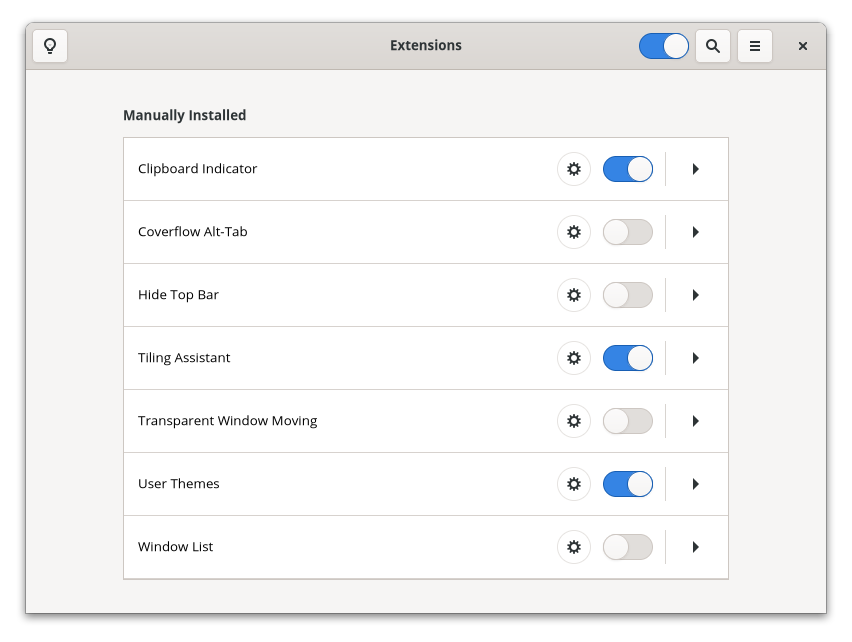
Install applications
When you first install Fedora Linux, you will find several installed apps. You can add other applications according to your needs with GNOME Software. Do the same way to open GNOME Software as described earlier. Then find the application you want, select the application, and then press the Install button.
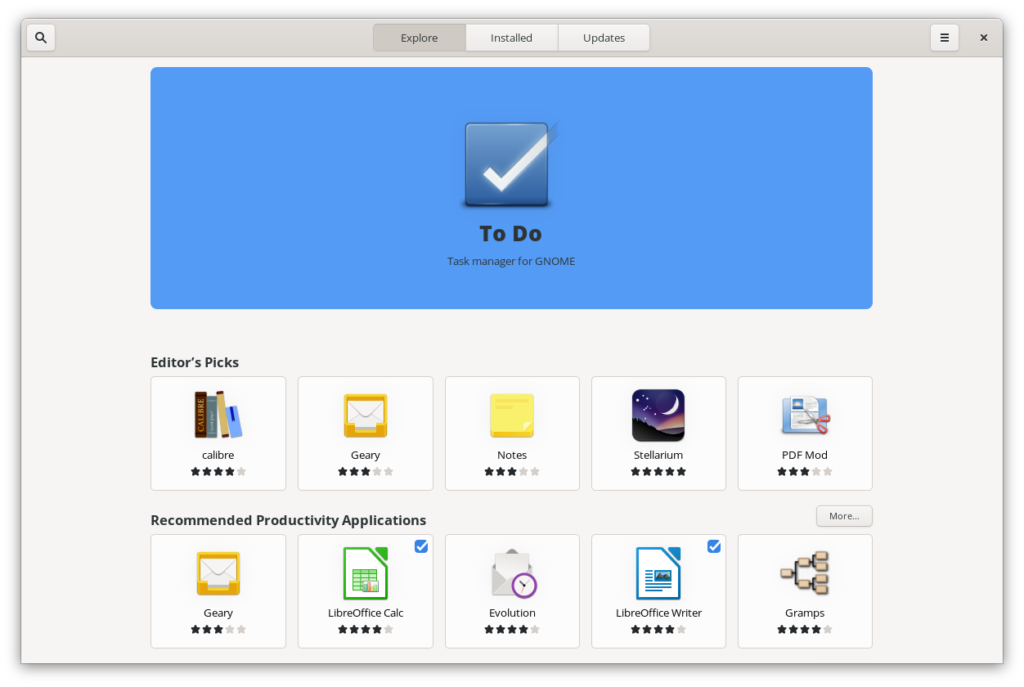
Or you can do it with terminal. Here are the commands to find and install the application.
Command to search for available applications:
$ sudo dnf search application_name
The command to install the application:
$ sudo dnf install application_name
Commands to remove installed applications:
$ sudo dnf remove application_name
note: replace application_name with the name of the application.
You can search for installed applications by viewing them in Show Applications. Select Activities or press the super key and select Show Applications. Then you can select the application you want to run from the list.

Conclusion
Fedora Workstation is an easy-to-use and customizable operating system. There are many things you can do after installing Fedora 34 Workstation according to your needs. This article is just a basic guide for your first steps before you have more fun with your Fedora Linux system. You can read Fedora Docs for more detailed information. I hope you enjoy using Fedora Linux.

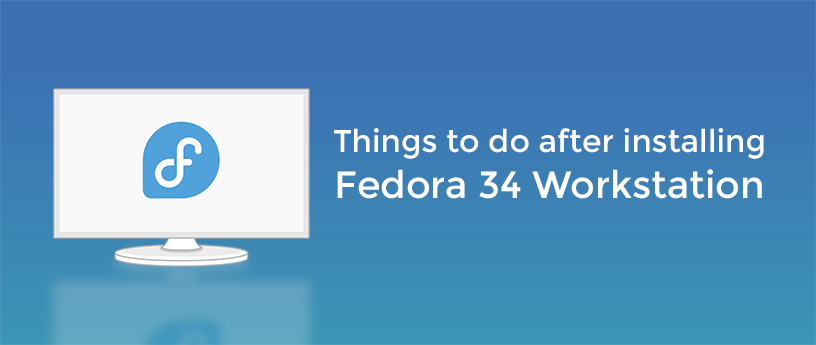




Rizqi N. Assyaufi
Great article!
Articles on the topic of “thinks to do after installing Fedora” are always needed by newcomers.
A little curious, why setting fastestmirror and deltarpm are not available by default in inside /etc/dnf/dnf/conf file?
Wello
Fastest mirror? The explanation could be a bit long but for short: easy load on the mirrors near you.
Delta RPM is enabled by default. The author is helping you to ensure it.
Matthias Lätzsch
Nice. Thank you. Well explained.
Ludwig Wilhelm
The man page for dnf.conf says the default for deltarpm is True anyways.
Is that…True?
Wello
Exactly. You can verify it by yourself: notice when you do dnf update, sometimes Delta RPM saved you some percentage of data or by looking the download stream and see some packages are downloaded as DRPM.
Hedayat
Due to some infrastructure changes (https://github.com/fedora-infra/bodhi/issues/2406), DeltaRPM support is almost non-existence because there are usually no delta rpms in the repository for you to use so it barely makes any change to the amount you should download.
Hope it starts to really work again soon (although, with no activity for about 3 years about this, I really don’t have much hope 🙁 )
Gregory Bartholomew
I think if Matthew Almond’s RPM Copy on Write patch makes it into Fedora Linux 35, it might obsolete DeltaRPM.
Klaas
If you recommend to use dnf to upgrade then you should also recommend to use fwupdmgr — fwupdmgr refresh && fwupdmgr update — for firmware updates.
If you’re using gnome software this is done for you automatically.
Carlos Escobar
My firmware updates stopped working since a while, I don’t why, they don’t work with Gnome Software neither with terminal, my laptop is a Lenovo x280.
I can see the new updates listed in both methods (Gnome software and terminal).
Weird.
Ralf
Nice article! I always have one single problem after setting up my Fedora system. That’s email. I tried different solutions, but I haven’t found the best one and to be honest: No single solution seems to fit my security needs and sorry guys: No single solution is comparable to the solutions available in the Office 365 suite for example.
I’m totally happy with Fedora, but I need a stable e-Mail solution with advances security features and settings. I already doubt my capabilities because I don’t seem to have a secure system in place yet. I don’t want to go into details…
Now what to do? Virtualization, Containerization, a secure native client (which one?), a dedicated e-mail-server for my small office, a separate non-Fedora installation, what else? I’m searching for a perfect solution for a small office with a single user, rather than an enterprise grade environment.
I’m really desperate because I would like to have everything on one computer.
Thunderbird: no.
Dave Sherratt
To implement e-mail, including a server, on your machine, you need to install the following components and configure them.
(1) A message, or mail, transfer agent (MTA), aka mail server, e.g. Exim.
(2) A message, or mail, delivery agent (MDA), e.g. Dovecot (this has security features).
(3) A mail user agent, or mail client, e.g. Thunderbird.
Ralf
Thanks. That sounds interesting.
Michael Walsh
Thank you for your post.
I have been a Thunderbird user for about 15 years and have been satisfied with it, but I have always wondered if there was a better email client that is “better” than Thunderbird and that works for Windows, MacOS and Linux (acknowledging that “better” is a pretty vague adjective that means very different things for different people).
I would like to know what problems you see with Thunderbird that I might have missed.
Ralf
E-mail security is generally a difficult task. It pops-up regularly in different security related podcasts or CVE reports. Can’t be very specific here, but Thunderbird doesn’t work for me. It’s more a personal preference. Sorry that I’m a little inaccurate here.
Ralf
Probably an article about the configuration of Thunderbird would be helpful?
I’ve found a couple of config files recently.
hammerhead corvette
The “Hamburger” Menu is probably the most underrated mention in this article. I have watched reviews of Fedora, and it’s always noted that the distribution is “missing” something. All of tha is in the hamburger menu and it is always overlooked. “Software Repositories” and “Update Preferences” is always overlooked in reviews of the distribution following comments that Fedora is difficult because of this overlooked option.
Thanks for covering this !
Pamfeuer
Very simple but absolutely necessary and priceless!
This article must be pinned as it saves headaches, any new additions are welcome.
From a 20 year unixer.
lemc
How about services that can be disabled after a fresh install of Fedora? It would be helpful to have guidance on that.
Darvond
You know, I still find it absolutely baffling that GNOME Tweaks is considered a requirement just to change a simple theme. It’s Kai Krause’s Padded Cell Ideal taken to the wrong extreme. (The fact that XML is mandated as the slideshow format is just bletcherous on another level.)
Or requiring extensions for what is also considered basic functionality.
Maybe I’ve spent too much time in i3 & Sway, where things are much more level with the user: A well commented configuration file that treats the user as an adult, rather than treating them as a cognitively impaired child.
One of the comments mentions the triple bar menu as if it’s some amazing discovery, but it more seems like poor UI design if it takes this article to point it out. Would it not be more accessible to present all the window settings in various tabs with internationalized symbols; saving both on localization and size?; (since GNOME could always stand to slim down a bit)
And another comment seems to not understand that Deltas changed to be automatically applied rather than relying on any manual infrastructure. Perhaps this could be noted in an article somewhere.
Ralf
There had been a couple of articles about the tiling window manager (https://i3wm.org/docs/userguide.html). It seems to be much work at the beginning. I tried it without any reading upfront, and it wasn’t very intuitive.
To be honest, the first extension I was searching for was the one to allow desktop Icons.
(https://extensions.gnome.org/extension/2087/desktop-icons-ng-ding/).
I wasn’t very happy with that external solution neither.
I would spend more time on i3 (haven’t tried Sway until now), but there are many tweaks that can make it more usable. (YouTube helps). I would like to see more articles about tweaking i3 and make it more user friendly for non programmers or newcomers.
Darvond
Which is absolutely fair. Even though i3 does configure first install via a wizard, there are absolutely things which a little GUI could go towards. Like a configurator to help a user deal with the config syntax.
Here’s my suggestion: Install nwg-launchers and try nwggrid.
As to the matter of GNOME extensions, they’re never a permanent solution. With GTK4 in progress, I can’t imagine that the compatibility will be matched going forward, nor the will of extension devs to keep at it. GNOME could just adopt many of the extensions into the mainline code, but I presume that’d violate some internal policy.
Ralf Seidenschwang
Thanks a lot for the hint. I’ve found an older book covering the Exchange Server in two book volumes. Time does not allow to read both books entirely, so I need to set strict priorities.
I will come back to your recommendation, the project looks very interesting!
I recently wanted to take the time to learn the Go programming language, but time does not allow it. I like C++, but my skills are…let’s say expandable… I hope to find a little more time for that.
Best regards!
Ralf Seidenschwang
Maybe it will work out after all, who knows: https://golangrepo.com/
Interesting!
Ralf Seidenschwang
By the way, the job offering was a failure. my recent comments are no long applicable.
Alif Radhitya
This article is very comprehensive, great for users who are new to Fedora
Bengt Fredh
Good and useful post, I have a couple of comments:
From dnf(8) man page
dnf [options] update
Deprecated alias for the Upgrade Command.
You should direct users to use dnf upgrade (or dnf up)
fastestmirror=true has been a hit and miss for me. Lowest ping does not meen good download. I have better experience whit:
max_parallel_downloads=10
Find a number that good for your location.
Ralf
Or you define your own alias, e.g.
$ alias up=”sudo dnf upgrade”
and put it somewhere in your .bashrc file (that’s hidden in your home folder) to make it permanent.
Audun Nes
Great article. I have been using Fedora as my daily driver at home for 10 years straight now. Even before that I was using Fedora on and off since Fedora Core 1. But I still learn new things everytime I read Fedora Magazine.
The dnf group with Multimedia is certainly something I will try to to get rid of other 3rd party dependecies I am currently using.
Regarding deltarpm, I thought that was turned on by default?
fastestmirror is another option I will try.
Thanks for making such an amazing magazin!
You Really Don't Want to Know
I started using fedora33 because the debian installer failed on my new laptop (two old ones died in February). Of course I hate everything but ‘dnf’ is pretty nice and I managed to get everything back (SSDs are nice too).
Thunderbird. Would. Not. Work.
Claws Mail is a very good replacement. Interface is quite similar and most things work better.
Vernat
Also you can add to /etc/dnf/dnf.conf
max_parallel_downloads=10
Maximum value is 20
Slinus02
The First thing i’d do in a Fedora Stock Installation would be to remove the hideous Gnome Desktop entirely and Install KDE.
But then again Arch Linux is better anyway.
Darvond
Alright, let’s see your hand. How is Arch better?
Slinus02
Well First off, Arch doesn’t come with Gnome. That makes it heaps better already.
But all Jokes aside, I Just Like Arch better because I can choose whatever the hell I want to Install. No preinstalled DE, not even a DHCP client and what I like best, no snap, no flatpak and no damn App Store. Just Pacman and for all the specialty Software there’s the AUR for you. Also, I have gotten everything I’ve ever wanted to run on a Linux system on Arch but never on one of those easy peasy mousy clicky distros.
Vernat
Looks like you have a lot of free time 😉
Ralf Seidenschwang
I like Manjaro Linux (https://manjaro.org/download/), which is based on Arch, very easy to install and it provides features like up/downgrading the kernel on a running system by a simple click. The design is very neat and it runs smoothly. By default, it comes with a lightweight XFCE desktop (the prettiest I have ever seen).
In the case your Fedora installation doesn’t run as expected, it’s definitively worth a look. One drawback is that Arch doesn’t use SELinux by default, if you need that. I think other Linux Security Modules are available, but haven’t checked that.
Darvond
Fedora can do exactly all the things you’ve just mentioned; there’s the NetInstall or Everything if you want to be choosey. Yes, they aren’t championed as the mainline edition, but the choice to start just as threadbare as Arch is there.
Ralf
Sure. My main distribution is Fedora, since I like all the stuff that‘s build with CoreOS or FCOS or however you want to call it. That’s the reason why a stay with Fedora or RHEL in generell. The is much you can build with or on top of the two distributions
svsv sarma
Arch never supported all Asian languages which I want. But for that it is ok. you get everything in Fedora too and for me it is readymade OS.
Kevin
Since people are asking about security requirements of email, I hope you understand that just because your connection to an email server is secure, that you aren’t under the impression that when the email leaves the server, it will most likely be sent to the next mail exchanger in cleartext. If you are paranoid, please use PGP or GPG to encrypt the message. If people on the receiving end aren’t willing to use these tools, then the message probably isn’t that important.
As far as functional email clients, I’ve had good luck with evolution, even when interfacing with broken microsoft exchange servers.
Ralf
I don’t understand why the connection to an exchange server sometimes works, and sometimes the tab with that special Microsoft email account doesn’t even load in Evolution. That doesn’t seem to be an external problem. I’m using Fedora 33.
Right now, printer spoolers are under attack (Microsoft fixed vulnerabilities in June and in July), besides these awful ransomware attacks via remote maintenance systems and the password manager of Kaspersky produces insecure keys they recently announced after a long period of inactivity and non-disclosure.
Windows isn’t more secure. That wasn’t my message.
Nevertheless, Evolution doesn’t run very stable on my system. Probably a misconfiguration, but I can‘t work with that in a business-like environment.
svsv sarma
A very useful tip indeed for all versions / specific version. occationally, sudo dnf upgrade -y | sudo dnf clean all | sudo dnf autoremove -y boosts system response.
Bleachbit and Timeshift may help further.
This tip could be displayed on a welcome screen after os boot.
However, I pocketed it.
Thank you.
Jared G
This article makes the reasonable assumption that most newbies will use GNOME as their default desktop environment. Like a lot of folks, I imagine, I find it stunning and bizarre that GNOME 3 still does not permit the use of desktop icons by default. Indeed, as the article suggests, these and other deficiencies can be remedied through the installation of GNOME extensions. However, there is a BIG caveat that you will surely want to bear in mind whenever using these extensions.
Because Fedora releases aggressively track the latest available upsteam versions of GNOME, which are more recent than those found in most other highly popular Linux distributions, it is often the case that upgrading your GNOME installation will break some of the extensions you rely on to make your desktop more user-friendly. These GNOME packages are only major version-upgraded between release cycles of Fedora (to improve stability), but this is still something to consider carefully before upgrading your system from one Fedora release to the next.
If you would prefer to avoid these GNOME-related issues entirely, I’d recommend checking out Fedora Spins for some alternative pre-configured desktop environments. I think XFCE, for example, is wonderful choice because it cuts out virtually all cruft while remaining extremely usable. (This suggestion is more of a “Thing to do before installing Fedora 34 Workstation,” but worth mentioning because a little planning ahead can save you lots of trouble down the road. YMMV!)
Mark
Having gone from Fedora 31 to 34, reset vi/vim as default editor…
Christoph
One of the first things i did after my upgrade was looking into slow boot times and found this as a workaround to my problem: https://bugzilla.redhat.com/show_bug.cgi?id=1976653#c4
It seems like dracut-initqueue job waits for dbus with a timeout, but dbus cannot spawn so early in the initialization of the system.
Maybe it can help somebody!
Cheers, CR
RubenKelevra
The Gnome Software stuff doesn’t work for me. I clicked on “update” and there’s a bar running left and right, but there seems to be no progress. I waited for half an hour and the bar is still running left and right.
I mean, does it download anything? Does it search for stuff? I don’t know.
But I could close it by pressing on the X, while it’s doing this. So is my system now in an unclean state? Does the update continue? I don’t know.
I feel like the Software Center of Gnome UX is pretty bad actually. And why are there no automatic updates? Like, why do I have to wait for updates to be downloaded and be ready to be installed? Just do this and notify me when I have to confirm that I want them to be installed and reboot.
Paolo
Why is the Gnome Tweaks & Gnome Extensions app not integrated into the Gnome settings?
It seems strange that everyone has to do the same post installation routine and that you even had to write an article to remind people to do it …
my 2 cents after 20 years of Linux / Gnome / Kde …
Ralf Seidenschwang
I would have a question about partitioning. I have a Unified Extensible Firmware Interface (UEFI) system with GUID Partition Table (GPT). All other systems I’m booting on the machine via this disc do not use the /boot partition that the fedora installer creates automatically. My filesystem for the fedora partition is encrypted and I’m using rEFInd for my boot selection/menu.
It took a long time to set up the system and it should be perfect. I now have. Is there any need for the /boot partition or can I delete it and the system will still boot?
Thomas
Nice article worth reading by Fedora newbies.
The things I usually do after upgrading (or installing) a Fedora release is:
– being scared about broken Gnome extensions
– being scared about Gnome changes
– being afraid to pick a non-rpm repo (such as flatpak) when installing software
Yes I know there’s spins and flavors of Fedora that could solve my issues or are probably suited more for my needs. And my preferences and tool chain might be wrong. But hey, that’s what I’m used to, that’s how I’m quick and effective in daily tasks.
I’ve left Fedora for PopOS on my desktop and for RockyLinux on my laptop. I used to run Fedora everywhere and it still runs my servers, but for workstations, the bleeding edge philosophy isn’t working for me anymore. Dash To Dock (even the “ewlsh”-fork) is impossible to use thanks to Gnome, plus their understanding of restructuring settings / extension etc.
Don’t get me wrong, I love the gnome experience but with Fedora 34 (rather Gnome 3.4x) so many things became “tradeoffs” that I just wisched I could have the old gnome back. Which is the case (at least for SOME time) with Pop and Rocky.
Still longing to return to Fedora workstation someday, Cheers, Thomas